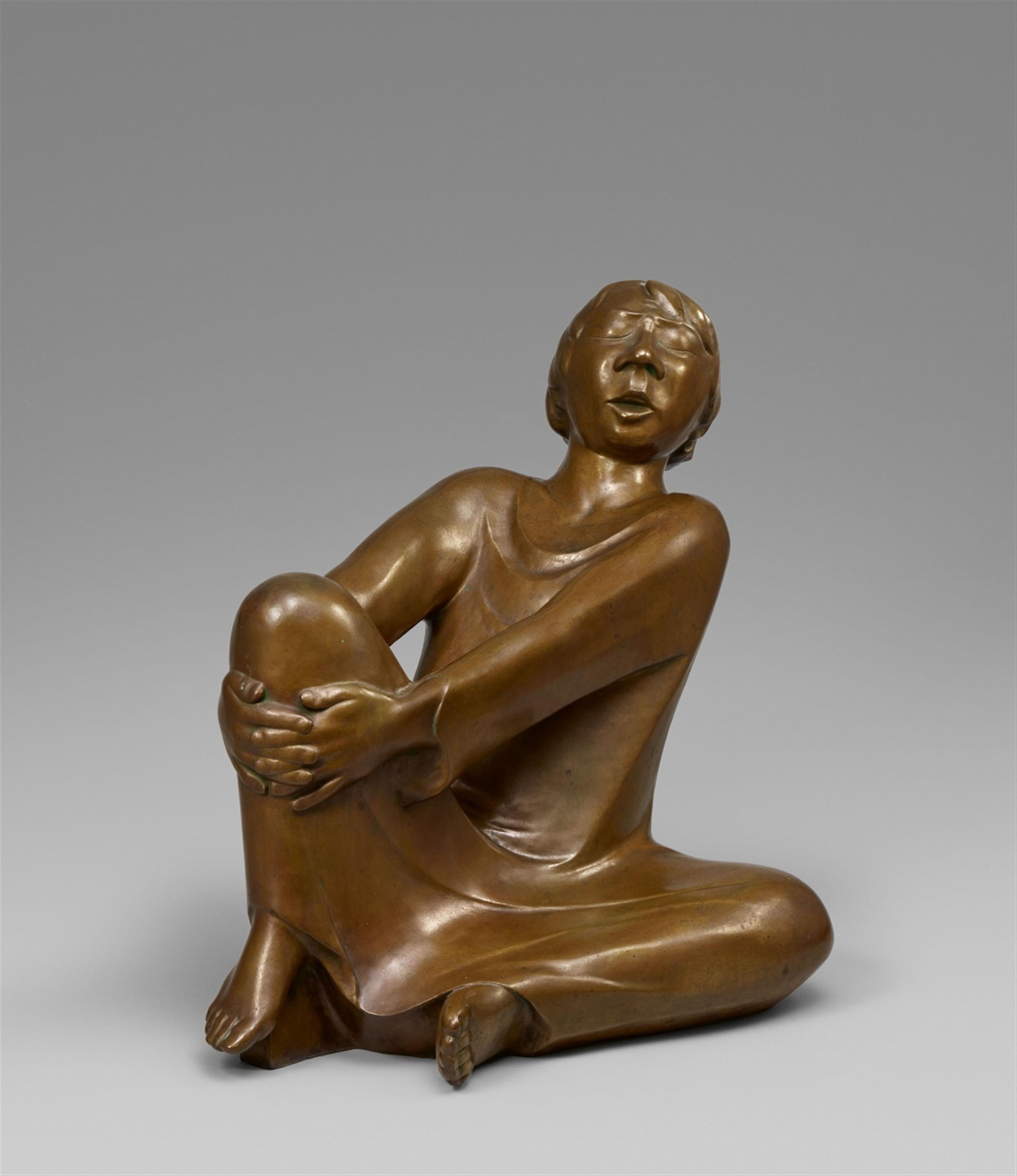Ernst Barlach
Der singende Mann
1928
Bronze Height 49.5 cm Signed 'E. Barlach' on the back below the right foot and foundry mark 'H. NOACK BERLIN'. From a total edition of 57 exemplars mentioned by Laur, of which approx. 16 were early lifetime casts from the edition of the Flechtheim Gallery. The present exemplar probably from the beginning of the 1950s. - With lively golden olive-coloured patina. Isolated superficial scratch marks at the head.
Faces with cheerful expressions are rather rare in Ernst Barlach's work or, to be more specific, they can be found only twice: with the “Singender Jüngling” of 1928/30 and "Lachende Alte", an old woman laughing with relief - a work in wood created in 1936/37. The artist conveys to his viewers an evident sense of spiritual release, which is presumably first and foremost experienced and then commented on by the otherwise so circumspect and serious sculptor himself: “Sometimes a cheerfulness without cause apparently deigns to descend directly from the heights of heaven down to earth to soften the accustomed depression, which then has to build up its gloom all over again, if it is unable to resist doing so.” (Ernst Barlach, Briefe, ed. by Friedrich Droß, Munich 1968, vol. II, p. 776).
The secondary literature constantly asserts the formative influence of the 1906 journey to Russia on Barlach's life and work, and it is supposed to have influenced sculptures created decades later: the simple contours, for example, or the great naturalness of expression. Austerely and with just a few gestural suggestions, Barlach models the pure mental state and temperament of the singer and renounces every secondary - not to mention decorative - detail. This was not the only work with which Barlach met the challenge he had once laid down for himself in purest contemplation: an austere formal composition, simple drapery falling in loose folds, reduced to almost Cubist forms, but nonetheless featuring an elegant ornamental arc in the “flow of lines”. A physiognomy that had come to characterise the artist's work conveys a distinctive concept and responds to a moving statement, independently of an iconographic gesture. Barlach may have been pursuing a sacral and perhaps also liturgical setting with this delightful, reclining and relaxed pose and, with the full-throated singing of the man, he created a figure which he used to describe - as he writes in his autobiographical “Selbsterzähltes Leben” (critical edition, ed. by Ulrich Bubrowski, Leipzig 1997, p. 72) - as in a “human situation in its nakedness between heaven and earth”, full of determination and with an expressive pose, entirely the opposite of the more statuesque impression of the sculptor's other works. To this extent the figure is ambiguous, as is demonstrated by Berthold Brecht's personal perspective on the sculpture. Brecht, a keen observer of his time, described the realistic and human quality of the “Singender Mann” in 1952 in the notes he wrote about a Barlach exhibition in West Berlin: “The singing man, a bronze of 1928, sings [unlike the three women of 1911] boldly, in a free pose, clearly working on his singing. He sings alone but seems to have listeners. Barlach's humour wishes him to be a little vain, but not more so than is compatible with the practice of art.” (Cited from: Der Bildhauer Ernst Barlach. Skulpturen und Plastiken im Ernst Barlach Haus - Stiftung Hermann F. Reemtsma, Hamburg 2007, p. 159).
Following the suicide of Barlach's gallerist Paul Cassirer in 1926, Alfred Flechtheim became responsible for handling Barlach's sculptural work and encouraged the sculptor, who had been “fixated” on wood up to that time, to increasingly utilise bronze to realise his sculptures. Thus, following the 1927 monument in Güstrow, the “Singender Mann” was among the first sculptures that Barlach conceived with “passion and conviction” in what was a new material for him.
Catalogue Raisonné
Laur 432; Schult I 343
Provenance
Private collection, Lower Saxony; Villa Grisebach auction no. 130, Ausgewählte Werke, Berlin, 25 November 2005, lot 27; European private collection
Literature
I.a.: Bronzen von Ernst Barlach, Galerie Flechtheim, November/ Dezember 1930, exhib. cat. Berlin/Düsseldorf 1930, no. 19; Alfred H. Barr, Omnibus, German Sculpture, Berlin/Düsseldorf 1932, pp. 38-42; Marguerite Devigne, Ernst Barlach, in: Les Beaux-Arts, Brussels 1935, p. 14; Carl Dietrich Carls, Ernst Barlach, Das plastische, graphische und dichterische Werk, 5th ed., Flensburg/Hamburg 1950, p. 58; Paul Fechter, Ernst Barlach, Gütersloh 1957, p. 35; Franz Fühmann (ed.), Ernst Barlach, Das Wirkliche und Wahrhaftige, Wiesbaden 1970, p. 159; Kunstblätter der Galerie Nierendorf, Ernst Barlach. Plastik, Zeichnungen, Graphik, 13 Sept. - 5 Dec. 1978, Berlin, September 1978, cat. no. 41 with illus. no. 21 (this exemplar); Anita Beloubek-Hammer, Ernst Barlach, Plastische Meisterwerke, Leipzig 1996, p. 116 f.; Helga Thieme, Ernst Barlachs Skulptur "Der singende Mann" in der Ausstellung "Neue deutsche Kunst", Oslo 1932, in: exhib. cat. Rostock 1998, p. 310 ff.
Exhibitions
According to Laur, casts can be found in the following museum collections: Neue Nationalgalerie, Berlin; The Cleveland Museum of Art, Cleveland/Ohio, USA; Museum am Ostwall, Dortmund; Ernst Barlach Haus, Hamburg; Sprengel Museum, Hanover; Kunsthalle Kiel; Museum Ludwig, Cologne; Kunsthalle Mannheim; Pinakothek der Moderne, Munich; Lyman Allyn Museum, New London/Connecticut, USA; Museum of Modern Art, New York, USA; Germanisches Nationalmuseum, Nurnberg; Schloss Gottorf, Schleswig; Staatliches Museum Schwerin; Rathaus Wedel, private possession (a numbered cast 4/10); Ernst Barlach Stiftung, Güstrow; Hamburger Kunsthalle; Von der Heydt-Museum, Wuppertal

